When you think of Thanksgiving, one of the first dishes that comes to mind is stuffing. It’s a classic side dish that pairs beautifully with turkey, bringing a warm and savory contrast to the meal. If you’re looking for a stuffing recipe that will elevate your holiday gathering, this Sage Stuffing Recipe for Turkey is the perfect choice. It combines crispy bread cubes, fresh herbs, and rich chicken stock to create a mouthwatering stuffing that’s full of flavor and texture. Whether you choose to stuff your turkey with it or bake it separately as a side, this recipe will make your meal unforgettable.
In this article, I will walk you through how to make the best sage stuffing for turkey, offering both the traditional stuffing-in-the-turkey method and a casserole-style side dish option. I’ll also highlight a few helpful tips and variations to ensure your stuffing turns out just right.
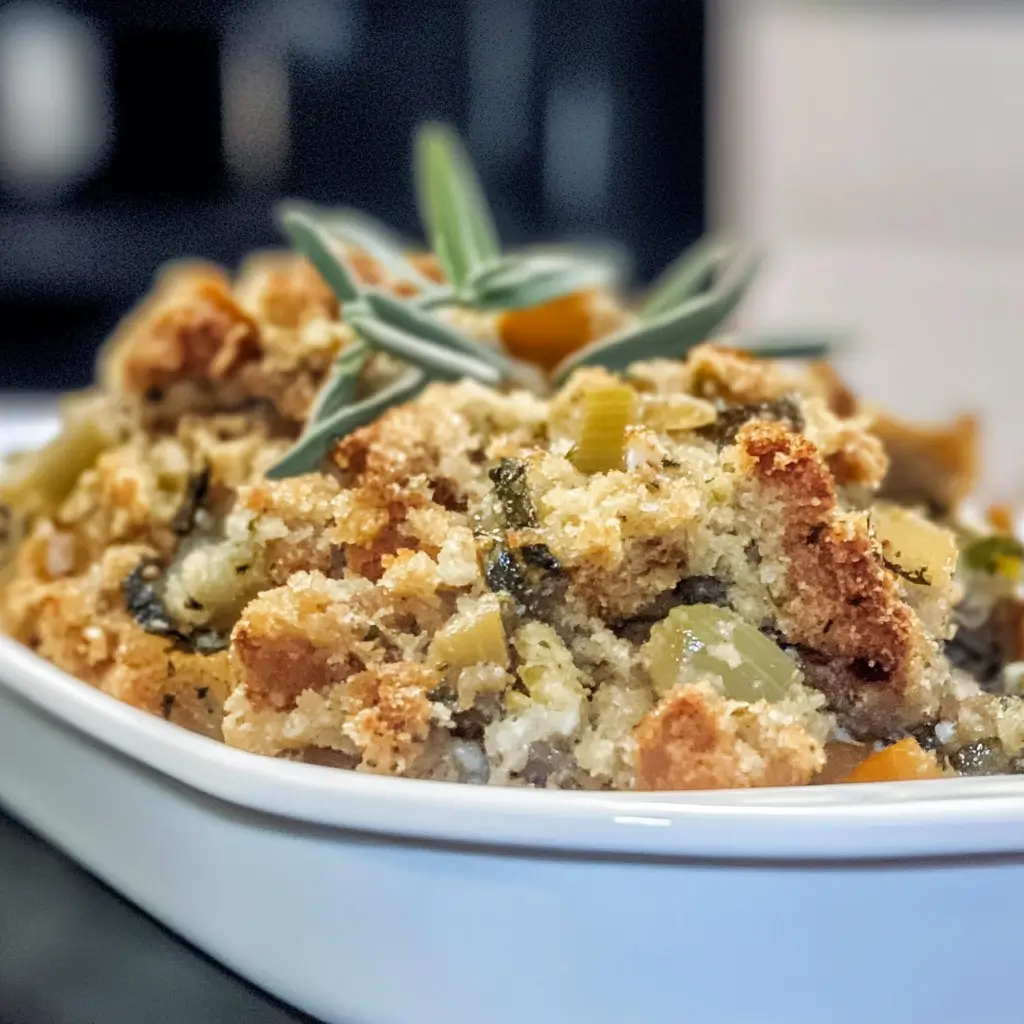
What is sage stuffing?
Sage stuffing is a savory mixture typically made with bread cubes, vegetables, herbs, and broth. It can be cooked inside a turkey or in a separate casserole dish. The key flavor in sage stuffing comes from dried sage, which has a slightly peppery, earthy flavor that complements turkey and other meats beautifully. This type of stuffing is perfect for Thanksgiving or any special dinner where turkey is the star of the show.
Ingredients for Sage Stuffing Recipe for Turkey
To create the best sage stuffing, you’ll need a few essential ingredients. Here’s a list to make sure you have everything ready:
- Bread—Day-old bread works best for stuffing. It absorbs the liquids in the recipe while retaining some of its structure. You can use white bread, whole wheat, or even gluten-free bread if preferred. Stale bread is ideal, but fresh bread can work too if you dry it out in the oven.
- Butter—The richness of salted butter brings depth to the stuffing. If you’re looking for a dairy-free alternative, opt for plant-based butter or olive oil.
- Celery—Chopped celery gives the stuffing a fresh crunch and enhances the flavor of the other ingredients.
- Red Onion—The red onion adds a subtle sweetness and crunch, complementing the earthiness of the sage.
- Fresh Parsley—A small amount of minced parsley adds brightness and a slight herbal note to the stuffing.
- Dried Sage—This is the signature herb for this stuffing recipe, providing that classic flavor we all associate with turkey stuffing.
- Dried Thyme—Thyme is a great complement to sage, bringing a mild earthy flavor and helping to balance the richness of the butter.
- Chicken Stock—This adds moisture and flavor. If you prefer, you can use turkey stock for a more intense flavor or vegetable broth for a vegetarian version.
- Egg—Eggs help bind the stuffing together, giving it that soft yet firm texture that’s so satisfying.
- Salt and Pepper—These are essential for seasoning the stuffing and bringing out the flavors of the herbs.
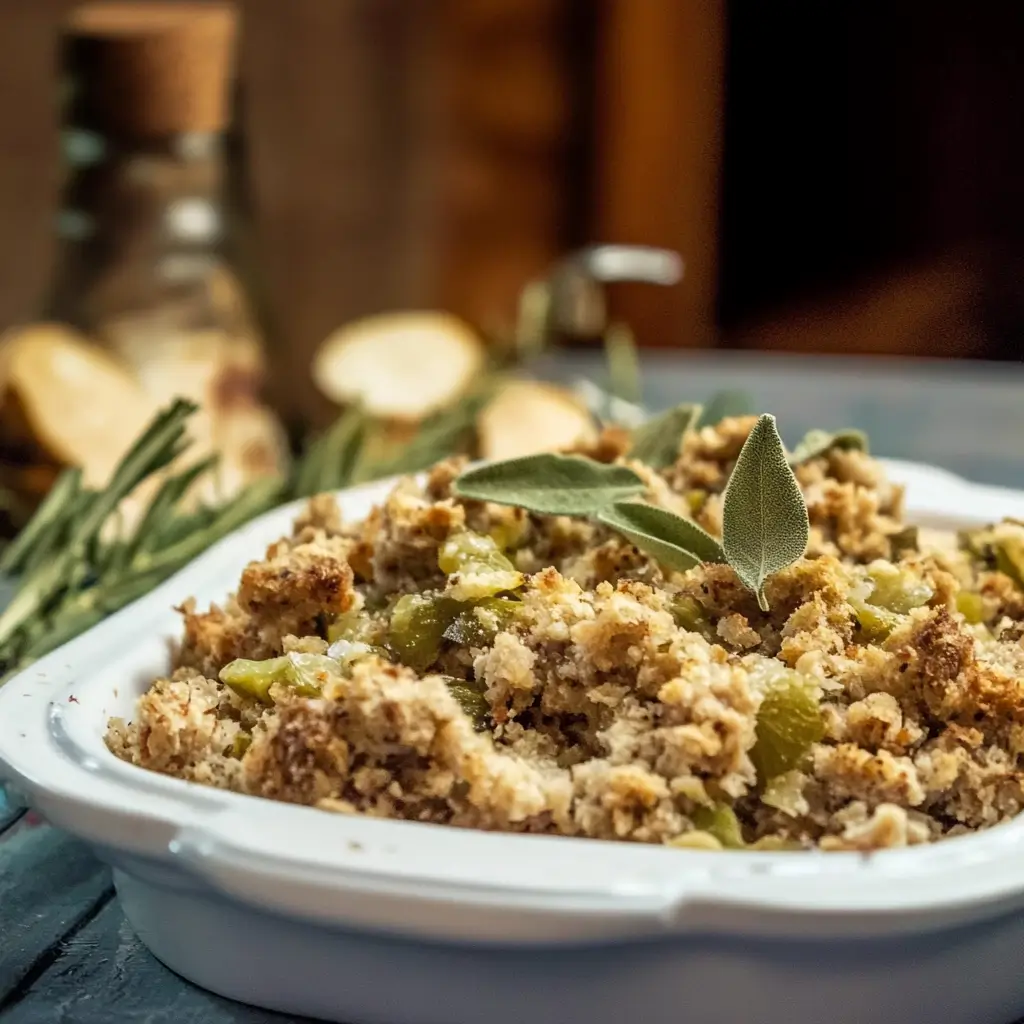
How to Make Sage Stuffing for Turkey
Now, let’s get to the heart of the recipe. Making sage stuffing from scratch may seem like a lot of steps, but it’s quite straightforward once you break it down. The following instructions are for making the stuffing, whether you plan to stuff it inside your turkey or bake it separately as a side.
Step-by-Step Instructions:
- Prepare the Bread Cubes
Preheat your oven to 350°F (175°C). Cut your loaves of bread into small cubes, about 1-inch in size. For a finer texture, you can pulse the bread cubes in a food processor, but be careful not to make breadcrumbs. Once cubed, place the bread on a baking sheet and bake for about 15 minutes. The goal is to dry out the bread and make it crispy, not to brown it completely. - Sauté the Vegetables
In a large skillet, melt the butter over medium heat. Add the chopped celery and red onion. Sauté the mixture until the onions are translucent and the celery becomes tender, about 5-7 minutes. The smell of the vegetables cooking will make your kitchen smell delicious! - Mix the Ingredients
Transfer the toasted bread cubes into a large mixing bowl. Pour the sautéed vegetable mixture over the bread, making sure to distribute the butter and veggies evenly. Add the minced parsley, dried sage, dried thyme, salt, and freshly cracked pepper. Stir everything together to combine. - Add the Broth
Pour in the chicken stock gradually, stirring as you go. The goal is to moisten the bread cubes without making the mixture soggy. If the stuffing seems a bit dry, add more stock, a little at a time, until it reaches a moist yet firm consistency. You should be able to form a ball with the stuffing, and it should hold its shape. - Bind with Egg
Beat one egg in a small bowl and stir it into the stuffing mixture. The egg helps bind the stuffing together and creates the right texture for baking. - Prepare for Cooking
At this point, you have two options. You can either stuff the mixture into your turkey or bake it separately. If you’re baking it as a side dish, proceed with the instructions below. If you’re stuffing your turkey, make sure the stuffing is cool before you stuff it into the turkey cavity. Be sure not to overstuff, as the stuffing will expand while cooking.
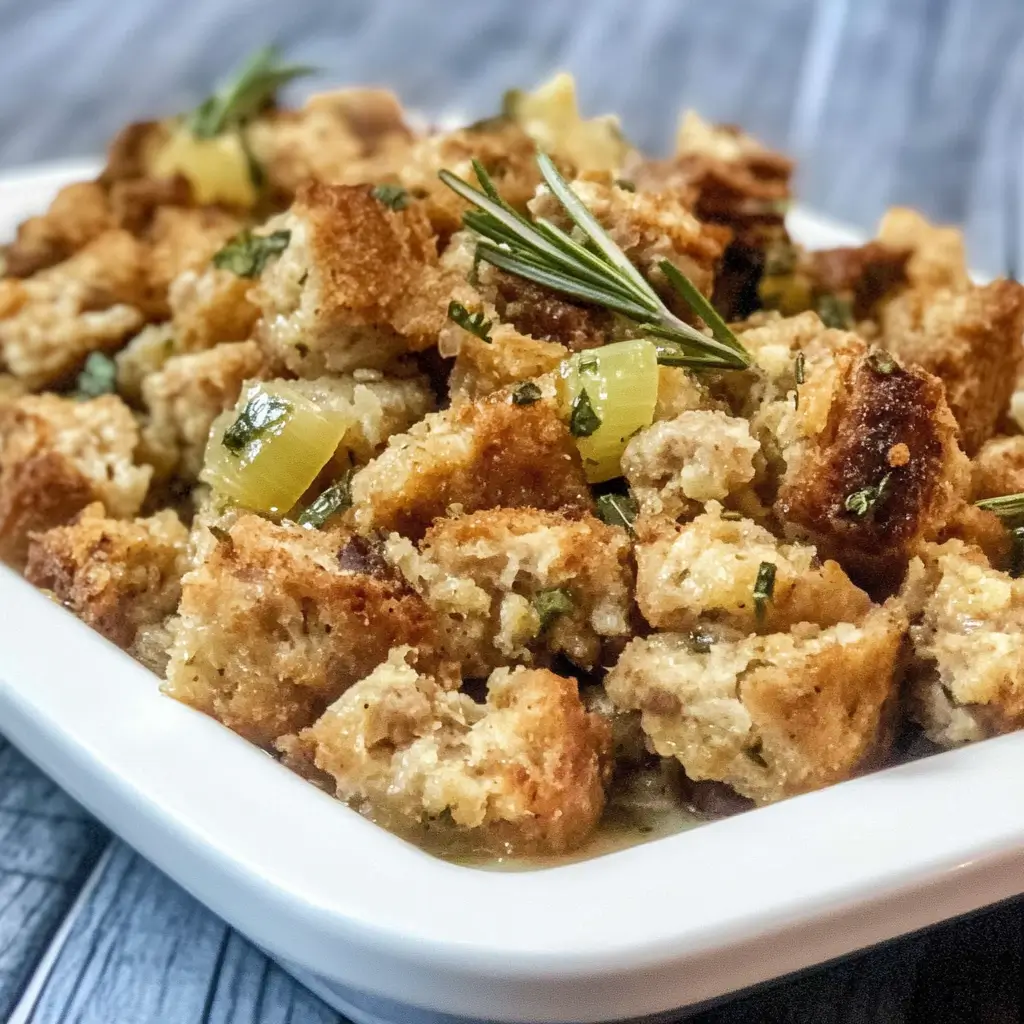
Baking Sage Stuffing as a Side Dish
If you prefer to bake the stuffing as a separate side dish rather than stuffing it into the turkey, here’s how you can do it. This method allows the stuffing to develop a crispy golden top, creating the perfect texture contrast to the soft inside.
Instructions for Baking the Stuffing:
- Preheat the Oven
Set your oven to 350°F (175°C). - Prepare the Baking Dish
Lightly grease a large casserole dish with butter, olive oil, or non-stick cooking spray. This will prevent the stuffing from sticking to the dish and help it crisp up. - Assemble the Stuffing
Transfer the prepared stuffing mixture into the greased casserole dish. Spread it out evenly to ensure it bakes uniformly. - Cover and Bake
Cover the casserole dish with aluminum foil and bake for 30 minutes. This allows the stuffing to steam and cook through without drying out. - Uncover and Finish Baking
After 30 minutes, remove the foil and continue baking for an additional 15 minutes. This step helps the top of the stuffing become golden and crispy, adding a delicious texture. - Serve
Once the stuffing is baked and the top is beautifully browned, remove it from the oven. Let it rest for a few minutes before serving. The crispy top and soft inside make for a perfect side dish to accompany your turkey.
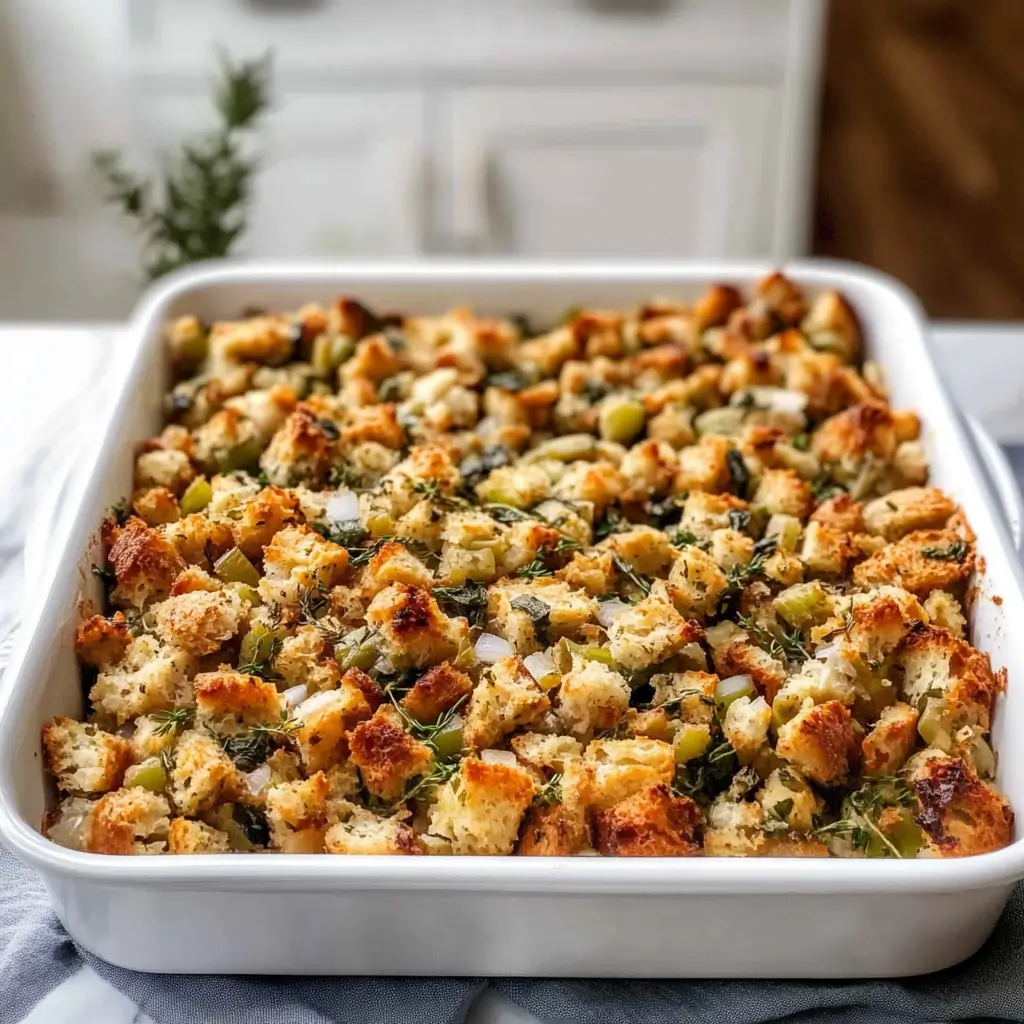
Stuffing the Turkey with Sage Stuffing
For a truly traditional experience, you can stuff the mixture inside the turkey. Stuffing the turkey with this sage stuffing recipe ensures that the flavors meld beautifully as the turkey roasts, infusing the bird with rich, savory flavors. Here’s how to do it:
Instructions for Stuffing the Turkey:
- Prepare the Stuffing
Make sure the stuffing is completely cooled before you stuff it into the turkey. This is crucial for food safety, as hot stuffing can raise the temperature of the turkey’s interior too quickly, creating an unsafe environment for bacteria growth. - Stuff the Turkey
Carefully spoon the stuffing into the turkey cavity, packing it loosely. Do not overstuff the turkey, as the stuffing will expand during cooking, and a tight pack could lead to uneven cooking. - Tie the Legs and Secure the Opening
After the stuffing is in place, tie the turkey legs together with kitchen twine. You can also secure the opening of the turkey with skewers or by folding the skin over the stuffing. - Roast the Turkey
Follow the turkey’s roasting instructions based on its weight and your preferred cooking method. Usually, it’s about 15 minutes per pound at 350°F (175°C), but always check the internal temperature. The turkey should reach 165°F (75°C) in the thickest part of the thigh, and the stuffing should also reach 165°F (75°C) to ensure it’s fully cooked. - Rest and Serve
Once the turkey is done, remove it from the oven and allow it to rest for at least 20 minutes. This helps the juices redistribute and makes for a juicier turkey. Carefully remove the stuffing from the turkey cavity and transfer it to a serving dish.
Tips for the Best Sage Stuffing
To make sure your sage stuffing turns out perfectly every time, here are some helpful tips to keep in mind:
- Use Day-Old Bread: Fresh bread can become too soggy when mixed with the broth. Day-old bread absorbs the liquid better and holds its structure. If you don’t have day-old bread, you can leave fresh bread cubes out overnight to dry them out.
- Don’t Overstuff: When stuffing the turkey, make sure you don’t pack the stuffing too tightly. Overstuffing can prevent the turkey from cooking evenly and can lead to soggy stuffing.
- Add Extra Flavor: For an extra layer of flavor, try adding sautéed mushrooms, garlic, or a bit of sausage to the stuffing. These ingredients enhance the overall depth of the stuffing’s flavor profile.
- Use Fresh Herbs: While dried sage is a staple in this recipe, using fresh herbs like thyme or rosemary can add an extra burst of flavor. Just make sure to chop them finely before mixing them in.
- Moisture is Key: For moist stuffing, be sure to add enough broth. The stuffing should be wet enough to form into a ball but not so wet that it becomes soggy. If in doubt, add more stock until it reaches the desired texture.
Variations of Sage Stuffing Recipe for Turkey
This sage stuffing recipe is incredibly versatile. Here are some variations you can try to suit your taste preferences:
Sausage and Sage Stuffing
Adding sausage to your sage stuffing gives it a rich, savory flavor. Simply crumble some cooked sausage (pork, turkey, or chicken) into the stuffing mixture. The sausage will add both flavor and moisture, making the stuffing even more indulgent.
Cranberry and Sage Stuffing
For a sweet and savory twist, incorporate dried cranberries into the stuffing. The tartness of the cranberries provides a delightful contrast to the earthiness of the sage and complements the rich flavor of the turkey.
Apple and Sage Stuffing
Adding diced apples to the stuffing gives it a subtle sweetness. Choose a tart apple, such as Granny Smith, to balance the savory elements. The apples will soften as they bake, adding both flavor and moisture to the stuffing.
Gluten-Free Sage Stuffing
If you need a gluten-free option, simply use gluten-free bread in place of regular bread. The texture may differ slightly, but the flavors will still shine through. Be sure to use gluten-free broth or stock as well.
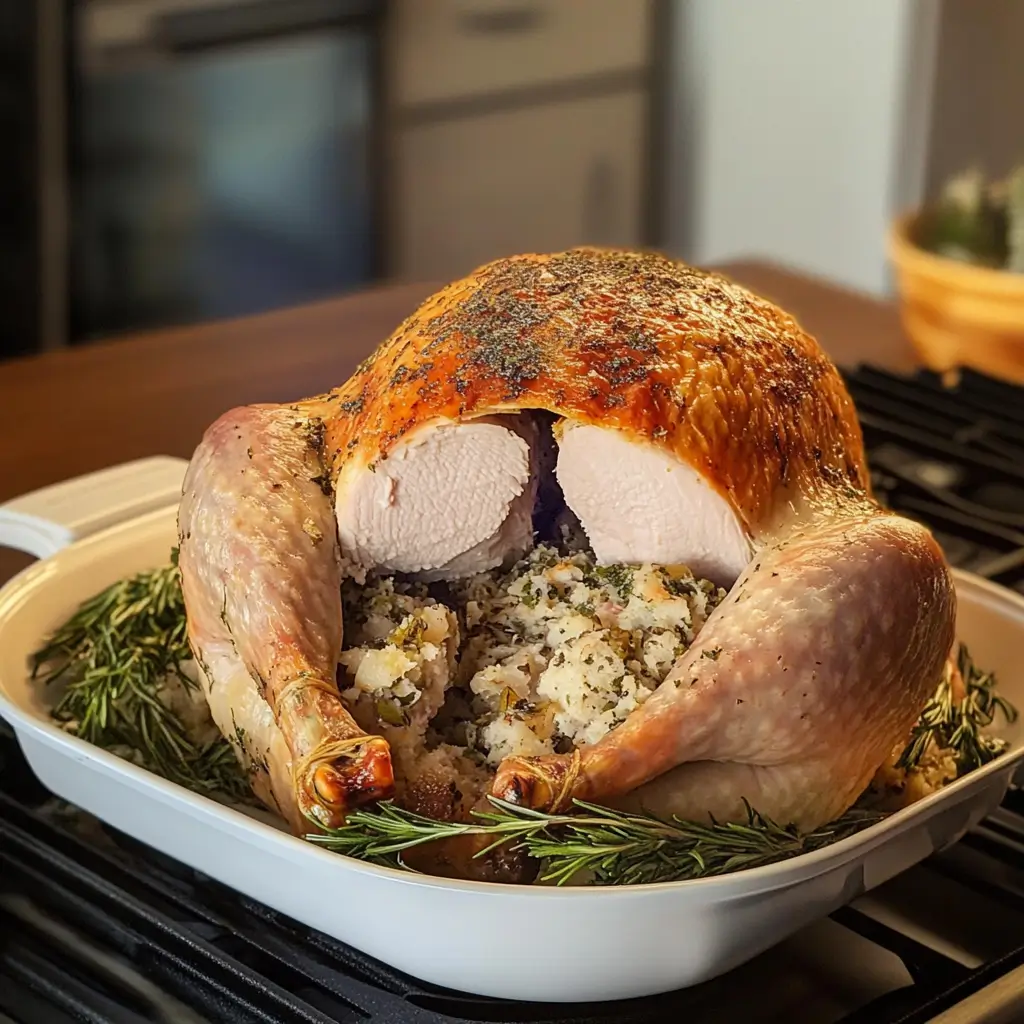
FAQs On Sage Stuffing Recipe for Turkey
Can you use sage in turkey stuffing?
Yes, sage is a key ingredient in turkey stuffing. It’s the signature herb that gives the stuffing its distinctive flavor. The earthy, slightly peppery taste of sage pairs perfectly with turkey and enhances the overall flavor of the stuffing. It’s best to use dried sage, but fresh sage can also be used if finely chopped.
Is rubbed sage or ground sage better for turkey?
Both rubbed sage and ground sage can be used in turkey stuffing, but they serve slightly different purposes. Rubbed sage is dried sage leaves that are crushed into small pieces, which gives the stuffing a more textured and fragrant flavor. Ground sage is a fine powder and imparts a smoother, more subtle taste. For a more intense flavor with some texture, rubbed sage is a great choice. However, if you only have ground sage, it will work well too.
Do you fully cook stuffing before putting it in the turkey?
No, you do not fully cook stuffing before placing it in the turkey. The stuffing should be prepared and then cooled before being stuffed inside the bird. The turkey will cook the stuffing from the inside as it roasts. However, the stuffing should not be too hot when placed inside the turkey to prevent the turkey from reaching unsafe temperatures during cooking. Make sure to check the stuffing’s internal temperature; it should reach 165°F (75°C) for safe consumption.
Do you put sage and poultry seasoning in stuffing?
Yes, you can put both sage and poultry seasoning in your turkey stuffing. Sage is the primary herb in the stuffing, but poultry seasoning—usually a blend of sage, thyme, rosemary, and other spices—can add depth to the flavor. Combining the two will create a well-rounded, aromatic stuffing that complements the turkey perfectly.
Is it better to cook a stuffed turkey at 325 or 350?
It’s generally better to cook a stuffed turkey at 325°F rather than 350°F. Cooking at 325°F allows the turkey to cook more slowly and evenly, ensuring that both the meat and the stuffing reach the proper temperature without drying out. Cooking at 350°F may cook the turkey faster, but there’s a risk that the stuffing may not fully cook, or the turkey could dry out. Always check that the internal temperature of both the turkey and stuffing has reached 165°F (75°C) for safe consumption.
Sage Stuffing Recipe for Turkey
Ingredients:
- 2 loaves day-old bread (white, whole wheat, or gluten-free)
- 1/2 cup salted butter (or plant-based butter for dairy-free)
- 2 cups chopped celery
- 1 medium red onion, finely chopped
- 1/4 cup fresh parsley, minced
- 2-3 tablespoons dried sage (or 6 tablespoons fresh, finely chopped)
- 1 tablespoon dried thyme
- 2-3 cups chicken stock (or turkey stock, or vegetable broth)
- 1 large egg
- Salt, to taste
- Freshly cracked black pepper, to taste
Instructions:
- Preheat the Oven: Preheat your oven to 350°F (175°C).
- Prepare the Bread: Cut the loaves of bread into small cubes, about 1-inch in size. Place the cubes on a baking sheet and bake for 15 minutes until the bread is dry and crispy.
- Sauté the Vegetables: In a large skillet, melt the butter over medium heat. Add the chopped celery and onion. Sauté for 5-7 minutes until the onion becomes translucent and the celery is tender.
- Mix the Ingredients: Transfer the toasted bread cubes into a large bowl. Pour the sautéed vegetable mixture over the bread and stir in parsley, sage, thyme, salt, and pepper.
- Add the Broth: Gradually pour in chicken stock, mixing as you go. Add enough broth until the stuffing is moist but not soggy.
- Bind with Egg: Beat the egg and stir it into the stuffing mixture, ensuring everything is well combined.
- Cook: Stuff the mixture into your turkey cavity or transfer it to a greased casserole dish and bake. For a casserole, cover with foil and bake at 350°F (175°C) for 30 minutes, then uncover and bake for an additional 15 minutes until golden and crispy.
Notes:
- Storage: Store leftover stuffing in an airtight container in the refrigerator for up to 3 days.
- Make-Ahead: You can prepare the stuffing a day or two ahead of time. Simply assemble, cover, and refrigerate. Bring to room temperature before baking.
- Customization: Add sausage, apples, or cranberries to change the flavor profile.
- Turkey Stuffing: If using the stuffing inside a turkey, ensure it’s cooled before stuffing, and don’t overstuff to allow for even cooking.
Nutritional Facts (per serving, based on 10 servings):
- Calories: 190
- Total Fat: 10g
- Saturated Fat: 5g
- Cholesterol: 35mg
- Sodium: 450mg
- Total Carbohydrates: 22g
- Dietary Fiber: 2g
- Sugars: 4g
- Protein: 4g
Recipe Information:
- Prep time: 20 minutes
- Cook time: 45 minutes
- Total time: 1 hour 5 minutes
- Method: Baking, Sautéing
- Cuisine: American
- Servings: 10
- Calories: 190 per serving
- Yield: 10 servings






